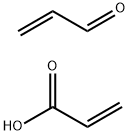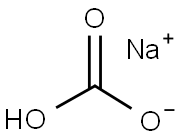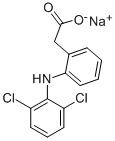Sodium 2-propylpentanoate
Synonym(s):Sodium valproate;Valproic acid sodium salt;Sodium 2-propylpentanoate;2-propylpentanoic acid sodium;2-Propylpentanoic Acid, Na
- CAS NO.:1069-66-5
- Empirical Formula: C8H15NaO2
- Molecular Weight: 166.19
- MDL number: MFCD00078604
- EINECS: 213-961-8
- SAFETY DATA SHEET (SDS)
- Update Date: 2025-01-27 09:38:02

What is Sodium 2-propylpentanoate?
Description
Sodium Valproate (1069-66-5) is a histone deacetylase inhibitor (IC50 = 400μM).1 Demonstrates neuroprotective, anticancer, and anti-inflammatory activity.2? Inhibits Aβ production, reduced neuritic plaque formation, and improved memory deficits in Alzheimer’s mouse models.3? Improves stem cell reprogramming efficiency and enables efficient induction of pluripotency without introduction of the oncogene c-Myc.4 Clinically useful anticonvulsant.
Chemical properties
White Solid. Colorless crystalline powder, hygroscopic, very soluble in water (ca. 0.66 g/mL of solution), soluble in ethanol (ca. 0.2 g/mL of solution), practically insoluble in chloroform and diethyl ether.
Originator
Anticon,Generics-UK,UK
The Uses of Sodium 2-propylpentanoate
Antiepileptic; increases levels of GABA in the brain
The Uses of Sodium 2-propylpentanoate
antibacterial
The Uses of Sodium 2-propylpentanoate
Anticonvulsant
What are the applications of Application
Valproic acid sodium salt is an HDAC inhibitor with anticancer, anti-inflammatory and neuroprotective effects
Definition
ChEBI: The sodium salt of valproic acid.
Manufacturing Process
(a) Di-n-propyl cyanacetic acid
First of all, a sodium n-propylate solution was prepared from 7.42 g (0.322
mol) of sodium and 180 ml of anhydrous n-propanol, by heating with gentle
reflux until complete dissolution of the sodium.
Into a 500 ml spherical flask, equipped with a dropping funnel, a mechanical
stirrer, a thermometer and a condenser, above which was disposed a calcium
chloride trap, were introduced 16.95 g (0.141 mol) of ethyl cyanacetate and
40.69 g (0.33 mol) of n-propyl bromide. This mixture was heated to 45°C and
then there was added thereto, slowly and while stirring, the previously
prepared solution of sodium n-propylate, keeping the temperature of the
reaction medium at 50°-55°C by gentle external cooling.With the completion of the operation of introduction, the mixture was brought
to reflux temperature in 30 minutes and kept at this temperature for 3 hours.
The n-propanol was then distilled and the distillation stopped when the
temperature of the residual mass had reached 115°C.
The crude ester obtained in this way was then treated with a solution of 7.5 g
of flaked sodium hydroxide in 67.5 ml of water. The mixture was introduced
into a 250 ml spherical flask, equipped with a condenser, and then the
reaction medium was slowly brought to 60°-70°C. This temperature was
maintained for 3 hours, whereafter the mixture was cooled to about 50°C and
the ethanol which had formed and the residue of n-propanol were eliminated
under a pressure of 70 mm Hg. The solution thus obtained was cooled to
20°C and acidified, while stirring, by addition of 26.25 g of 36% hydrochloric
acid. During this operation, the temperature of the reaction medium was kept
below 40°C by cooling. Stirring was continued for 30 minutes, whereafter the
mixture was left standing for 30 minutes. The oily layer of di-n-propyl
cyanacetic acid was decanted and the aqueous phase extracted with 35 ml of
toluene. The extract in toluene was then added to the decanted di-n-propyl
cyanacetic acid, whereafter the solution in toluene was washed, in a
separation funnel, with a solution of 1.5 g of sodium chloride in 14 ml of
water. The toluenic phase was decanted and the toluene distilled under
atmospheric pressure.
Using this procedure, 25 g of crude di-n-propyl cyanacetic acid were obtained.
(b) Di-n-propyl acetonitrile
Into a 100 ml spherical flask fitted with a thermometer and a condenser were
introduced 25 g of crude di-n-propyl cyanacetic acid obtained by the method
previously described, and the mixture was heated on an oil bath.
Decarboxylation commenced at a temperature in the region of 140°C. The
mixture was refluxed at about 160°C and at 190°C for 2 hours. This
temperature was maintained until the release of gas was completed, this
taking 2 hours. The di-n-propyl acetonitrile thus formed was then slowly
distilled and the fraction passing over between 165°C and 175°C was
collected. A second distillation was then carried out. Using this procedure,
14.7 g of di-n-propyl acetonitrile were collected. Boiling point: 170°C. Yield:
83%, relatively to the ethyl cyanacetate used. Di-n-propyl acetonitrile may be
saponifyed with equal molecular quantity of NaOH to give the desired valproic
acid (valproate). After that it may be converted into the sodium salt with help
of equivalent NaOH to give the valproate sodium.
brand name
Convulex (Byk – Gulden, Promonta Lundbeck), Depakene/Depakote/ Valcote (Abbott), Depakine/Epilim/Ergenyl (Sanofi), Leptilan (Novartis), Orfiril (Desitin Arzneimittel)
Therapeutic Function
Anticonvulsant, Antiepileptic
General Description
A cell-permeable, short-chained fatty acid that inhibits histone deacetylase activity (IC50 = 400 μM for HDAC1). Induces differentiation and inhibits proliferation of cell lines derived from human malignant gliomas. At therapeutic levels (350 μM-1.04 mM), causes inositol depletion, inhibits both GSK-3α and -3β, activates the ERK pathway, and produces neurotropic effects. Has been used as an anti-epileptic agent. Also reported to stimulate peroxisome proliferator-activated receptor (PPAR) activity. Displays a potent teratogenic activity in humans and rodent models.
Biological Activity
Histone deacetylase inhibitor (IC 50 = 400 μ M) that exhibits anticancer, anti-inflammatory and neuroprotective effects. Displays anticonvulsive activity via an increase in GABA levels and decreases A β production in animal models of Alzheimer's disease. Also attenuates NMDA-mediated excitation, blocks voltage-gated Na + channels and modulates firing of neurons. Enables induction of pluripotent stem cells from somatic cells by Oct4 and Sox2.
Biochem/physiol Actions
Cell permeable: yes
Clinical Use
All forms of epilepsy Migraine prophylaxis (unlicensed)
in vitro
vpa showed to have cellular neuroprotective properties. in cultured neurons, vpa protected from thapsigargin-induced endoplasmic reticulum stress, glutamate-induced excitotoxicity, as well as lipopolysaccharide (lps)-induced dopaminergic neuronal death. in midbrain neuron-glia cultures, vpa was also shown to inhibit lps-induced, microglia-mediated inflammation [1].
in vivo
post-pmcao injections with vpa could decrease the brain infarct volume. postinsult treatment with vpa also reduced the number of microglia, suppressed microglial activation, and inhibited other inflammatory markers in the ischemic brain. the reduction in acetylated histone h3 was prevented by treatment with vpa. moreover, vpa superinduced heat-shock protein 70 and blocked pmcao-induced down-regulation of cyclooxygenase-2. the sensory, motor, and reflex performance of pmcao rats was improved by vpa treatment [1].
Drug interactions
Potentially hazardous interactions with other drugs
Antibacterials: metabolism possibly inhibited
by erythromycin; avoid with pivmecillinam;
concentration reduced by carbapenems - avoid.
Antidepressants: antagonise anticonvulsant effect;
avoid with St John’s wort.
Antiepileptics: concentration reduced by
carbamazepine; concentration of active carbamazepine
metabolite increased; increased concentration of
lamotrigine, phenobarbital, rufinamide and possibly
ethosuximide; sometimes reduces concentration of
active metabolite of oxcarbazepine; alters phenytoin
concentration; phenytoin and phenobarbital reduce
valproate concentration; hyperammonaemia and CNS
toxicity with topiramate.
Antimalarials: mefloquine antagonises
anticonvulsant effect.
Antipsychotics: antagonise anticonvulsant effect;
increased neutropenia with olanzapine; possibly
increases or decreases concentration of clozapine;
possibly increases quetiapine concentration.
Ciclosporin: variable ciclosporin blood level response.
Orlistat: possibly increased risk of convulsions.
Sodium oxybate: concentration of sodium oxybate
increased.
Ulcer-healing drugs: metabolism inhibited by
cimetidine, increased concentration.
Metabolism
Valproic acid is extensively metabolised in the liver, a large
part by glucuronidation (up to 60%) and the rest by a
variety of complex pathways (up to 45%).
It is excreted in the urine almost entirely in the form of
its metabolites; small amounts are excreted in faeces and
expired air.
storage
room temperature (desiccate)
References
1) Phiel et al. (2001), Histone deacetylase is a direct target of valproic acid, a potent anticonvulsant, mood stabilizer, and teratogen; J. Biol. Chem. 276 36734 2) Kim et al. (2007), Histone deacetylase inhibitors exhibit anti-inflammatory and neuroprotective effects in a rat permanent ischemic model of stroke: multiple mechanisms of action; J. Pharmacol. Exp. Ther. 321 892 3) Qing et al. (2008), Valproic acid inhibits Abeta production, neuritic plaque formation, and behavioral deficits in Alzheimer’s mouse models; J. Exp. Med. 205 2781 4) Hangfu et al. (2008), Induction of pluripotent stem cells by defined factors is greatly improved by small molecule compounds; Nat. Biotechnol. 26 795
Properties of Sodium 2-propylpentanoate
| Melting point: | 300 °C |
| Density | 1.0803 g/cm3 |
| storage temp. | 2-8°C |
| solubility | H2O: 50 mg/mL |
| pka | 4.8(at 25℃) |
| form | Fine Powder |
| color | White |
| PH | 6.0~9.0 (50g/l, 25℃) |
| Water Solubility | soluble |
| Merck | 14,9913 |
| Stability: | Stable for 1 year from date of purchase as supplied. Solutions in distilled water may be stored at -20°C for up to 3 months |
| CAS DataBase Reference | 1069-66-5(CAS DataBase Reference) |
Safety information for Sodium 2-propylpentanoate
| Signal word | Warning |
| Pictogram(s) |
 Exclamation Mark Irritant GHS07  Health Hazard GHS08 |
| GHS Hazard Statements |
H302:Acute toxicity,oral |
| Precautionary Statement Codes |
P201:Obtain special instructions before use. P202:Do not handle until all safety precautions have been read and understood. P264:Wash hands thoroughly after handling. P264:Wash skin thouroughly after handling. P270:Do not eat, drink or smoke when using this product. P301+P312:IF SWALLOWED: call a POISON CENTER or doctor/physician IF you feel unwell. P308+P313:IF exposed or concerned: Get medical advice/attention. |
Computed Descriptors for Sodium 2-propylpentanoate
| InChIKey | AEQFSUDEHCCHBT-UHFFFAOYSA-M |
Sodium 2-propylpentanoate manufacturer
CEFA CILINAS BIOTICS PVT LTD
New Products
(R)-1-Boc-3-hydroxypyrrolidine Methyl (R)-1-Boc-4,4-difluoropyrrolidine-2-carboxylate 2,2-Difluoropropylamine hydrochloride tert-butyl 3-bromoazetidine-1-carboxylate DIFLUOROACETIC ANHYDRIDE 2,2-Difluoropropionic acid Diallylamine, 99% Calcium hydroxide, 95% Aluminum oxide, basic 2-Bromophenylacetonitrile, 97% L-tert-Leucine,97% N-Hydroxy-2-methylpropanimidamide 4-(3,4-Dichlorophenyl)-3,4-Dihydro-N-Methyl-1-(2H)-Naphthalenimine (Schiff Base) 2-AMINO-3,5-DIBROMO BENZALDEHYDE [ADBA] L-Glutamic Acid Dimethyl Ester Hcl 10-Methoxy-5H-dibenz[b,f]azepine 5-Cyanophthalide N, N-Carbonyldiimidazole (CDI) Dibenzoyl Peroxide Titanium Dioxide 2-(Methylthio) Benzonitrile Sodium Acetate Anhydrous Allopurinol 1,5-DibromopentaneRelated products of tetrahydrofuran








You may like
-
 1069-66-5 Valproic Acid 98%View Details
1069-66-5 Valproic Acid 98%View Details
1069-66-5 -
 1069-66-5 98%View Details
1069-66-5 98%View Details
1069-66-5 -
 Sodium valproate 95% CAS 1069-66-5View Details
Sodium valproate 95% CAS 1069-66-5View Details
1069-66-5 -
 1069-66-5 98%View Details
1069-66-5 98%View Details
1069-66-5 -
 1069-66-5 Sodium valproate 99%View Details
1069-66-5 Sodium valproate 99%View Details
1069-66-5 -
 Sodium Valproate 99%View Details
Sodium Valproate 99%View Details -
 Sodium valproate, 98% CAS 1069-66-5View Details
Sodium valproate, 98% CAS 1069-66-5View Details
1069-66-5 -
 Sodium Valproate CAS 1069-66-5View Details
Sodium Valproate CAS 1069-66-5View Details
1069-66-5
